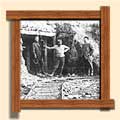


Home>> People and Communities>> People/Miner Profiles>> Drumheller Valley>> Frank Moodie
 |
|
Frank Moodie |
|
|
 Frank Moodie possessed ambition and determination
unparalleled in the
Drumheller Valley. When other mines in the
area shut down due to labour strikes, his was the only operation
that remained working. When his men were sick at the height of
the flu epidemic, he filled the role of a doctor, ultimately
saving lives in his camp. When Alberta first showed promising
signs of significant oil deposits, Moodie was already testing
ground and planning his next venture.
Frank Moodie possessed ambition and determination
unparalleled in the
Drumheller Valley. When other mines in the
area shut down due to labour strikes, his was the only operation
that remained working. When his men were sick at the height of
the flu epidemic, he filled the role of a doctor, ultimately
saving lives in his camp. When Alberta first showed promising
signs of significant oil deposits, Moodie was already testing
ground and planning his next venture.
Born in Chesterfield, Ontario, in 1878, Moodie had moved to Calgary by 1911. While prospecting near the Red Deer River, he discovered a sizeable coal seam not far from where John Nicholas Murray opened his Star Mine in 1911. In partnership with two railway builders, Moodie opened the Rosedale Mine in 1912.
There are two differing viewpoints on how Moodie organized his camp. On one hand Moodie was applauded. A 1919 edition of the Calgary Eye-Opener described an impressive operation, noting “The Rosedale Camp is one of the best equipped for the worker’s comfort.” However, other sources provide a contrary story. The research study It’s a Miner’s Life by J. E. Russel and the Historic Atlas Coal Mine note “For the first miners who arrived in the Valley, living conditions were appalling.” Men lived in overcrowded makeshift homes, with up to six men living in a shack no bigger than a chicken coop. Several shacks shared one outhouse, and sanitation problems no doubt caused annual health problems in the Rosedale camp.
The Spanish Influenza outbreak of 1918-1919 was particularly tough on the Rosedale miners, and for citizens of the whole Drumheller Valley. In the absence of doctors in the camp, Moodie worked tirelessly to save his miners. Employing medicines and fumigating material he supplied, many credit him for saving their lives, including nearby ranchers and homesteaders who came to him for help.
For all his compassion, Moodie was known as a hard and forceful man who refused to negotiate about labour demands. By the late 1910s, the Drumheller Valley was on the brink of becoming one of the most important coal fields in Alberta. Yet when miners came to the area, they saw atrocious labour and living conditions in the camps. At a time when unions were gaining strength, Moodie refused to have his camp unionized. Instead, he hired returning First World War veterans and brought in police from Calgary to protect against the Drumheller Strike of 1919. His determination paid off, and during the strike, his operation was the only working mine in the valley.
Moodie’s ambition and progressive attitude led him to pursue
ventures beyond coal mining. Despite critics who did not share
in his beliefs, he began to organize oil activities in Turner
Valley. If not for a car accident in 1938, and the subsequent
ill health he experienced, Moodie may have completed his oil
operations to much success. Instead, he succumbed to his failing
health in June 1943.
